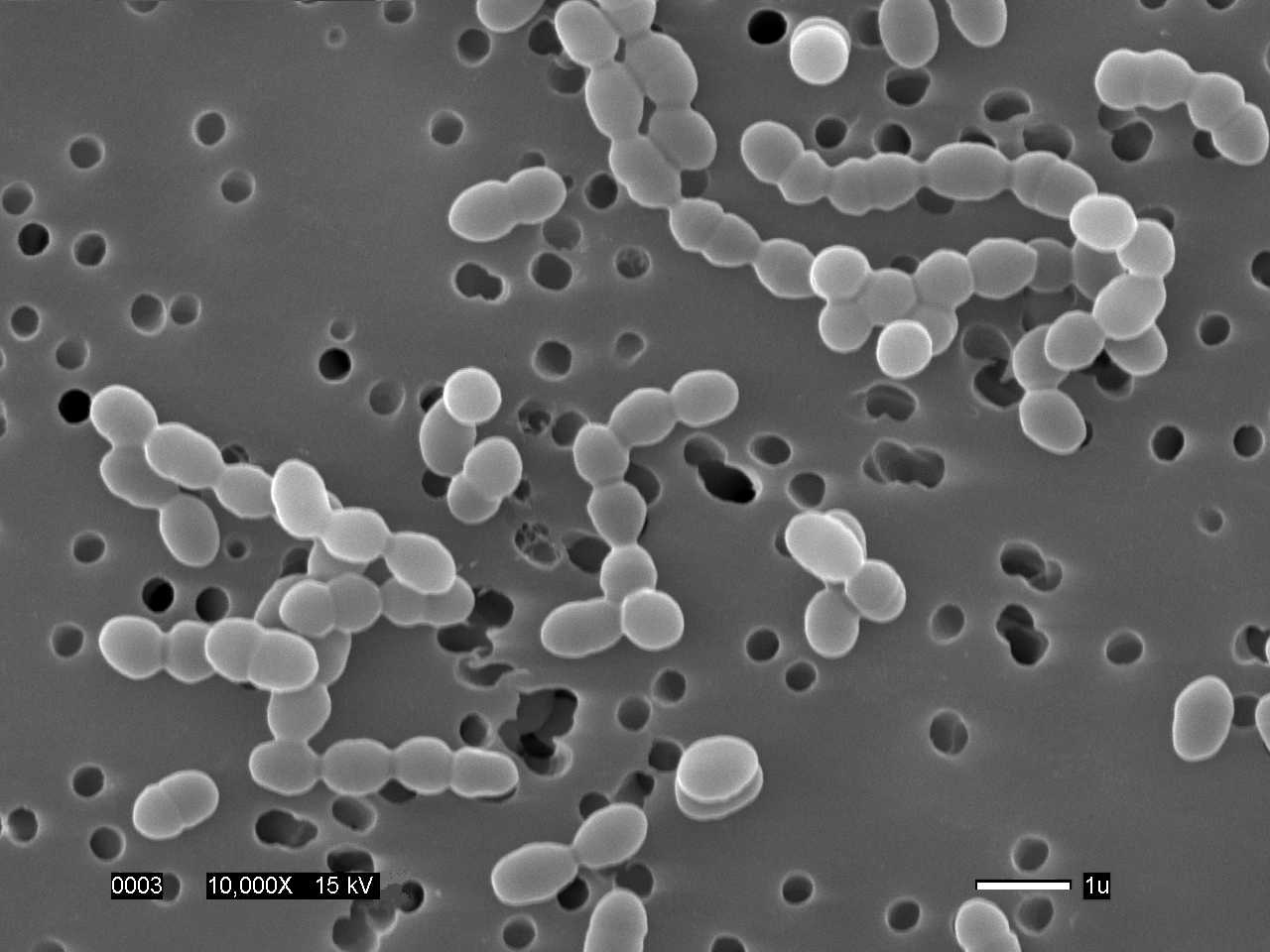| |
 Photo: Fred
Breidt, North Carolina State University
Photo: Fred
Breidt, North Carolina State University |
Leuconostoc species
are epiphytic bacteria that are wide spread in the natural environment
and play an important role in several industrial and food fermentations. Leuconostoc
mesenteroides is a facultative anaerobe requiring complex growth factors
and amino acids (Reiter and Oram 1982; Garvie 1986).
Most strains in
liquid culture appear as cocci, occurring singly or in pairs and short
chains, however, morphology can vary with growth conditions; cells
grown in glucose or on solid media may have an elongated or rod shaped
morphology. Cells are Gram positive, asporogenous and non-motile.
A variety of lactic
acid bacteria (LAB), including Leuconostoc species are commonly
found on crop plants (Mundt et al 1967; Mundt 1970). L. mesenteroides is
perhaps the most predominant LAB species found on fruits and vegetables
and is responsible for initiating the sauerkraut and other vegetable
fermentations (Pederson and Albury 1969). L. mesenteroides starter
cultures also used in some dairy and bread dough fermentations (Server-Busson
et al. 1999).
Under microaerophilic
conditions, a heterolactic fermentation is carried out. Glucose and
other hexose sugars are converted to equimolar amount of D-lactate,
ethanol and CO2 via a combination of the hexose monophosphate and pentose
phosphate pathways (Demoss et al 1951; Garvie 1986; Gottschalk 1986).
Other metabolic pathways include conversion of citrate to diacetyl
and acetoin (Cogan et al 1981) and production of dextrans and levan
from sucrose (Alsop 1983; Broker 1977).
Viscous polysaccharides
produced by L. mesenteroides are widely recognized as causing
product losses and processing problems in the production of sucrose
from sugar cane and sugar beets (Tallgren et al. 1999). The first observation
of the production of polysaccharide "slime" from sugar, dates
to the earliest days of the science of microbiology; Pasteur (1861)
attributed this activity to small cocci, presumably Leuconostoc species.
Commercial production dextrans and levans by L. mesenteroides,
for use in the biochemical and pharmaceutical industry, has been carried
out for more than 50 years (Alsop 1983; Sutherland 1996).
Dextrans are used
in the manufacture of blood plasma extenders, heparin substitutes for
anticoagulant therapy, cosmetics, and other products (Leathers et al
1995; Sutherland 1996; Alsop 1983; Kim and Day 1994). Another use of
dextrans is the manufacture of Sephadex gels or beads, which are widely
used for industrial and laboratory protein separations (Sutherland
1996). Currently, L. mesenteroides has significant roles in
both industrial and food fermentations.
References:
- Alsop, R. M.
1983. Industrial Production of Dextrans. Progress in Industrial
Microbiology., 1-42. ed. M. E. Bushell. New York: Elseiver.
- Broker, B. E.
1977. Ultra structural surface changes associated with dextran synthesis
by Leuconostoc mesenteroides. J. Bacteriol. 131: 288-92
- Cogan, T. M.
1987. Co-metabolism of citrate and glucose by Leuconostoc spp.: effects
on growth, substrates and products. J. Appl. Bacteriol. 63:
551-58.
- Cogan, T. M.,
M. O'Dowd, and D. Mellerick. 1981. Effects of Sugar on Acetoin Production
from Citrate by Leuconostoc lactis. Appl. Environ. Microbiol.
41, no. 1: 1-8.
- Demoss, R. D.,
R. C. Bard, and I. C. Gunsalus. 1951. The mechanism of heterolactic
fermentation: a new route of ethanol formation. J. Bacteriol.
62: 499-511.
- Garvie, E. I.
1986. Genus Leuconostoc. Bergey's Manual of Systematic
Bacteriology. eds. P. H. A. Sneath, N. S. Mair, M. E. Sharpe,
and J. G. Holt. Baltimore, MD: The Williams and Wilkins Co.
- Gottschalk,
G. 1986. Bacterial Metabolism. 2nd ed. New York: Springer-Verlag.
- Kim, D., and
D. F. Day. 1994. A new process for the production of clinical dextran
by mixed-culture fermentation of Lipomyces starkeyi and Leuconostoc
mesenteroides. Enzyme Microb. Technol. 16: 844-48.
- Leathers, T.
D., G. T. Hayman, and G. L. Cote. 1995. Rapid Screening of Leuconostoc
mesenteroides Mutants for Elevated Proportions of Alternan to
Dextran. Current Microbiol. 31: 19-22.
- Mundt, J. O.
1970. Lactic Acid Bacteria Associated with Raw Plant Food Material. J.
Milk Food Technol. 33: 550-553.
- Mundt, J. O.,
W. F. Graham, and I. E. McCarty. 1967. Spherical Lactic Acid Producing
Bacteria of Southern-Grown Raw and Processed Vegetables. Appl.
Microbiol. 15: 1303-8.
- Pasteur, L.
1861. Sur la Fermentation Visquese et la Fermentation Butyrique. Bull.
Soc. Chim., Paris 11: 30-31.
- Pederson, C.
S., and M. N. Albury. 1969. The Sauerkraut Fermentation. N.Y. State
Agr. Expt. Sta. (Geneva, N.Y.) Tech. Bull. Bulletin 824.
- Reiter, B.,
and J. D. Oram. 1982. Nutritional Studies on Cheese Starter. 1. Vitamin
and Amino Acid Requirements of Single Strain Starters. J. Dairy
Res. 29: 63-68.
- Server-Busson,
C., C. Foucaud, and J.-Y. Leveau. 1999. Selection of Dairy Leuconostoc
Isolates for Important Technological Properties. J. Dairy Res.
66: 245-56.
- Sutherland,
I. W. 1996. Extracellular Polysaccharides. 2nd ed. Biotechnology,
eds. H.-J. Rehm, G. Reed, A. Puhler, and P. Stadler, Vol 6: Products
of Primary Metabolism. New York: VCH.
- Tallgren, A.
H., U. Airaksinen, R. von Weissenberg, H. Ojamo, J. Kuusisto, and
M. Leisola. 1999. Exopolysaccharide-Producing Bacteria from Sugar
Beets. Appl. Environ. Microbiol. 65, no. 2: 862-64.
|

